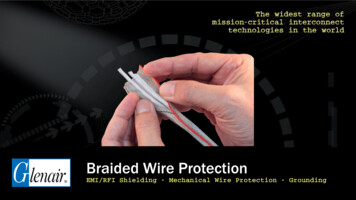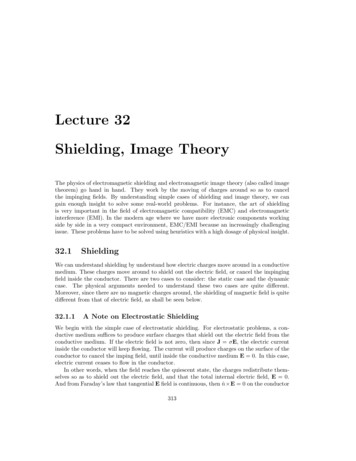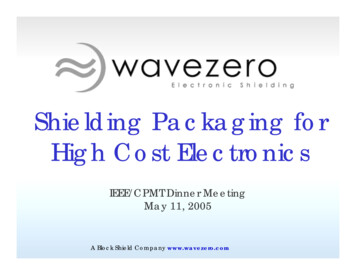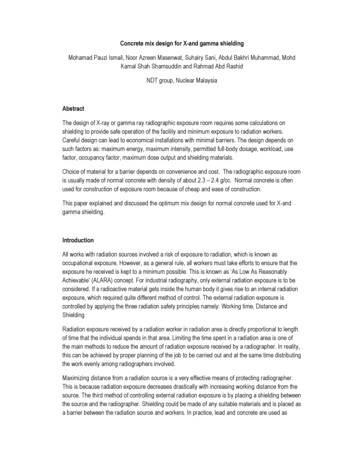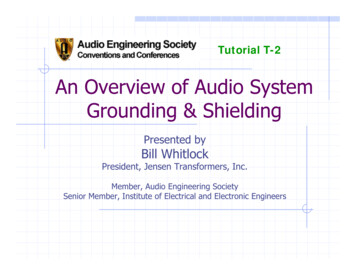
Transcription
NASADesignGuidelinesCurrentCarryingof Conductivityfor ShieldingCapability,of CompositeContractorReport4784Effectiveness,and the EnhancementMaterialsR. W. EvansTec-Masters,Inc. Huntsville,AlabamaPreparedNational Aeronautics and Space AdministrationMarshall Space Flight Center MSFC, Alabama 35812for Marshall Space Flight Centerunder Contract NAS8-39983and sponsored bythe Space Environments and Effects Programmanaged at the Marshall Space Flight CenterAugust1997
Ms.advice.who
ermination36
ofProtectionMethodsvi57
ProtectionREFERENCESPage6OReferencesvii
edffrequency(Hz)f ea(m thmtohenries,i0viiimetalboxsourceheightimpedance
fectivenessSEaBshieldingeffectivenessSEESpaceSE Eshieldingeffectiveness,electricfieldSE nsicimpedanceix(ohms)(ohms)metal(ohms)handbook)
Z nge permittivity(farads/m) xi0-12 yofrpermeabilityrelativeair(4 x10to-7 uctivityof( rconductivityrelativeCO2 fangular(1.724xi0tocopper(mhos/m)( cu-metercopper(mhos/m)tocopperfrequencyXorohm-8 ohmcm)meter)
S,CAPABILITY,1 .0inSHIELDINGafilters,However,spacecraftweight,
high strength,and ease of fabrication.composite materialsare not as electricallytraditionalmetal structures.Therefore,Despite these benefits,conductiveasextra steps must betaken to alleviatethis shortcoming.This document is partlytutorial,but it providesspecificguidelinesin the form of listsand chartsto sinspacecraft.
te,withorphenolic.boron,
Kevlar,and glass.Of these, only graphiteofferssome degree ofelectricalconductivity.Fortunately,graphitemats and longfibersare the reinforcementof choice for aerospace work.Other methods may be used to increase conductivity,such asadding conductivefillersto the resin.Conductive fillersareusuallysmall particleswith low aspect ratios(small length towidth) which are too small to provide reinforcement,and theycould reduce the strengthof the plasticalone.Typicalconductivefillersinclude graphiteflakes or fibers,metal coatedgraphitefibers,and metal flakes or fibers.Conductivitymay alsobe introducedby addingconductivescreen, plating,or paint to the finishedproduct.Increasingtheconductivityof finishedcomposite panels or cabinetsby adding aconductivecoatingis a common practicein the commercialelectroniccabinetindustry.The technologiesused to formconductivecoatingsinclude flame spray, arc spray, ating,ionplating,conductivefoilor tape, stic.All of these methods provide somedegree of shieldingwhen used on enclosures.Compliance with FCCrules may only require30 to 40 dB of electromagneticshielding.New plasticsand new methods of reinforcementare constantlybeing developed and introduced,but the composite most oftenchosen for aerospace use is some form of graphitefiber velessthanHowever,tojointsthethe
conductivityof GFRP is much higher than plasticalonewith nonconductivereinforcement,such as fiberglass.Some form of itytotapethe ssurelinearthepresentlygraphitetypeembedded in plasticor plasticIfapplication,ofaddedtheasfinishedpartof
raphitefilleror
coating may be considerablydifferent.Thicker materialadds someshieldingespeciallyat lower frequencies.Joints and apertureswilldegrade shieldingeffectiveness(SE) of the material,and theyare usuallythe limitingfactorin SE. Calculationsshould be madefor the specificcase using methods outlinedin table 4 of weenlayersoflayersofmustbefoil
continuousprotectionwithoutlarge gaps.Furthercan be found in section tecanhigherbeinintermediateisinformationlow inexpectedthetoseries.metalthecauseGFRPcoatingon lightninggalvaniccorrosionjoinedtoreducetoto
mstatedbefaceWheninofthe(ms) rially.b tyedgeFigureinisedge.by
nessofthesurface:theisknown,volume (1)tWhere,IfR surfacep volumet resistivityofamaterialrelativep volumeresistivityofaPen istributionThe1.724xi0nonconductivehigh.of fibers.toTheprovideconductivitya
than the composite materialbeing measured.Resistanceis thenmeasured end to end between the conductivesurfaces of the blocksample.Surface resistivityis the measured resistance(Rm) times thewidth,divided by the length in meters to give ohms per square.Volume resistivityin ohm-meters is attainedby multiplyingthesurface resistivityby the thicknessin meters.(3)p (4)R (t)Where,The surfaceRm:measuredw width1 lengtht thicknessP meabove.closetodependentasitdoes
4.2Conductivity.Conductivity(( yofthe( ofcopper:( r(6)-( cuWhere,(;r relative( conductivityconductivity( cu ityandshieldingstepsandfor( variousintablematerials2toshowandto
TableI.-StepstoConductivityExposeMake dingcontactto(o)theopposite: theendRmtoend.Iw)Rs(t)Tohms/square.ohm-meters.1-- mhos/meter. PRelativeconductivityr:( cuor,i. 724 10 -6----Rs XtcWhere,7cu:5.8xi0w:widthmhos/meter1 lengtht thicknesstom resistivityConductivity( randendsofasample.conductive ofconductiverectangularDetermine(meters)byapplying
,mC00et , u)u)"a:o(JQ. ,I--00'I110.1,LLII0,ILl,--dc o00,LLI,LLI000,,1.11 ILl006c d00,Ill0,ILl0 LLI00 ILl0coT0CO0CO0UJCILl0LLI0COcOcOoc oIoe4.10LLII--oc oo0:I.OrW o ,m14, . :iq: ::
3](7)Where,j:Vcf 2zff radians:permeability 4.3.1j isapproaches airr permeabilityofmaterialconductivity erialpermittivityofmaterialofair r rv mhos/meterto copper8.84xi0relativeimpedance,forrelative-7 H/mto-12 F/mairAirintrinsicconductivity,4Kxl0( oEr)permittivityof relative Impedancespace ( o r)( cu6r) yIntrinsicInofHz r:inocu houghi.e.,equation7becomes:Zair::15377ohms(8)
An electromagnetic(r)fromequalwave propagatingthe source,where r2Kthrough, the farairfield,at a distancehas an impedanceto Zair .In the near field,where r, the wave impedance depends2Kupon the source impedance and the distancefrom the source.Assuming the source is small compared to a wavelength( ), thewave impedance becomes:E- k377 ohmsHZw -(9)Where,E electricH magnetick i,iffieldfieldrstrengthstrength(V/m)(A/m) -2kk-, ifthesourceishighimpedanceandr 2Kr2ButZwcannotexceedthesourceimpedance.2Krk rmsZmandthree(Zm)ofrelative:369lessof (0 .timesthesourceimpedanceofAssumingthetheequation thanskin7adepthmetal,J rfMHzrthethickness(t of35),thethebecomes:(i0)olLms / eterminingconductivitymetalZwcopper:micro-o ums16persquare(10a)
Zm can also be expressedin terms of 99%calculatedbetweenatfivethis,itsforZm .Forskinthedepths.apparentthinmetal[4]ohms/square- is(ZB)Z nsiconeforanyvalueoft/6(ii)i:ZB--SZm - -5xtt6ohms/square(lla)t(or:2. 438xi0-ZB :ohms/squareC r tcm17(llb)
The ratio(K) of wave impedance to metal impedance is used todetermine reflectioncomponentsin .K --ZwZmfort 38(12)K --ZwZBfort 36(12a)and:18
ure3
may be used for quick SE estimatesfor composite materialswith aresistivityin the range of interest.For example, materialswithresistivitygreaterthan i0 ohms/square obviouslycannot be reliedupon for shielding.However, materialswith surface resistivityless than 0.001 ohms/square can provide SE approachingthat ofmetal when aperturesare izedmagneticformadeaswellcalculation"Quickas
000,i--I.I.Ip,4.1&.-I 1@oo,\I@uI.Ir,1:1\\o@/'rj.rlL'qr3Or.jiti iN@ //e14oH utllIIMMrt.! I.igo00Cq0O000--.1t--I0r-00--I( P)0O0as2100000
oo0JIi I00\0r-ii\\I -IImuiiir i iE! Li 6')Wi ioiI(4i L iU.0 0ml."C.iolmJ(,Oi .x.lLJ. -!o0o0od0co.,--0000 10oo(ep)3s2200
AbsorptionII.I Barriertakesthe
SE AdB RdB (13BdBWhere,TheA AttenuationRdB LossBoB correctiontermscanbee t" foundby8.686 tmthefollowing:[3&4]Absorption:AdB 201ogAOB 1314tcmQf z rOr 8.686tm -f o(14(14aWhere,t thicknessofsheetorpanel(morcm)Reflection:(I RdBWhereIntheKisfarfor 20foundinfield'planeK) 2K-log20log--4KequationsIr , forK I(154I2I12or12a.twaves:R i0 log rfMHz( r )108. 1 -Inthenearfield r --(15at2forforhighlowimpedanceERoB7 -- I0 log impedance141.Hfields:fields:24I 321rfsHzrm(15b)
R :74.6-101ogI(15Cr1fMHz( rr2mRereflection::BaB -20log(1SeefigureBdisBdBcana-- e-2t 4 e5fornegativebeXI0-01AdK Iignored(COS0. 23Ad-- j sin0. 23AdB(16-j2t 4 esissmall.BdB,totalknowingSE.AdBandK.
0iLJIoLILB0!JIII0OJ0CO''ILII0(BP) BIIJ0I.0.26;Ll1t0(,0ft0r-,,
nstantsTher ta quationscalculations,manyMethodar,andZ ooair.o( r---xpermeability10 -7 elativetometer)copper( cu1--absoluteconductivityofmaterialPcu:5.8p Rs xX 107tm meters)permeter)
Rs surfaceZs estimated(2)ofChooseresistivitysourcespecific(ohms per udingorganized:300(3)I -wavelength(meters)f z(4)0.00668--- skindepth(centimeters)sameunitsforX10 -6 4 r c rf M z(5)t-- (6)Zm (7)ZB 8ratio(use369 I r(f z)each)impedanceofmaterialwhentZ m Iimpedanceofmate
thickness and sound electrical bonding connections at joints are the primary components of a conductive structure. General guidelines for control of EMI can be found in the MSFC Electromagnetic Compatibility Design and Interference Control (MEDIC) Handbook, NASA Reference Publication 1368. [i] Equipment cases and the basic structure of .

